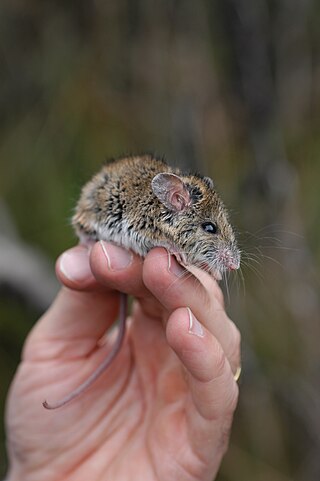Collier Range National Park is a national park in the Pilbara region of Western Australia, 878 km (546 mi) northeast of Perth.

Pseudomys is a genus of rodent that contains a wide variety of mice native to Australia and New Guinea. They are among the few terrestrial placental mammals that colonised Australia without human intervention.

Eucalyptus eremophila, commonly known as the sand mallet or tall sand mallee, is a species of mallet that is endemic to semi-arid regions of Western Australia. It has smooth pale brown and greyish bark, narrow lance-shaped to elliptical adult leaves, flower buds arranged in groups of between seven and eleven with an elongated operculum, and cup-shaped to barrel-shaped fruit.
The silky mouse is a species of rodent in the family Muridae. It is found only in Australia.
Western pebble-mound mouse or Ngadji is a burrowing and mound building rodent in the family Muridae. They occur in the Pilbara, a remote region in the northwest of Australia.

The little native mouse, also known as the delicate mouse, is a species of rodent in the family Muridae. The Kunwinjku people of western Arnhem Land call this little creature kijbuk.

The sandy inland mouse is a species of rodent in the family Muridae. Also known as the Hermannsburg (Mission) false-mouse or Hermannsburg mouse, it is endemic to Australia and found widely yet sparsely through arid and semi-arid areas.

The New Holland mouse also known as a Pookila is a species of rodent in the family Muridae. It was first described by George Waterhouse in 1843. It vanished from view for over a century before its rediscovery in Ku-ring-gai Chase National Park north of Sydney in 1967. It is found only in south east Australia, within the states of New South Wales, Queensland, Victoria, and Tasmania.

The western mouse or walyadji is a species of rodent in the family Muridae. Once widespread across a larger range, it has become restricted to around ten reserves of remnant bushland in Southwest Australia and declared near threatened by extinction. They are small and robust mice that live in burrows in sandy soil, venturing out at night to forage in nearby area.
Pebble-mound mice are a group of rodents from Australia in the genus Pseudomys. They are small, brownish mice with medium to long, often pinkish brown tails. Unlike some other species of Pseudomys, they construct mounds of pebbles around their burrows, which play an important role in their social life.

Eucalyptus gamophylla, commonly known as warilu, blue-leaved mallee, twin-leaf mallee, twin-leaved mallee or blue mallee, is a species of mallee that is native to Western Australia, South Australia and the Northern Territory. It usually has smooth bark, mostly only juvenile leaves arranged in opposite pairs, flower buds in groups of three, whitish flowers and cylindrical to barrel-shaped fruit that is four-sided in cross-section.

Triodia scariosa, is more commonly known as porcupine grass or spinifex, and belongs to the endemic Australian grass genus Triodia. The species is perennial and evergreen and individuals grow in mounds, called hummocks, that reach up to ~1m in height. The leaves are ~30 cm long, 1mm in diameter, needlepointed and rigid, and its inflorescence is a narrow, loose panicle that forms a flowering stalk up to ~2m in height. The name is derived from Latin; Triodia refers to the three-toothed lobes of the lemma, and scariosa is in reference to the thin, dry glume. The species is common to Mallee (MVG14) and Hummock grassland (MVG20) communities, in arid and semi-arid regions of Australia.

Scaevola basedowii is an erect multi-stemmed shrub in the family Goodeniaceae, endemic to Western Australia, the Northern Territory and South Australia.
Triodia irritans is a species of plant that forms low and dense mounds of tough grassy vegetation. It is found on sandplains in arid regions of southern and central Australia.

Leucopogon oliganthus is a species of flowering plant in the heath family Ericaceae and is endemic to the south-west of Western Australia. It is an erect, open shrub with white, tube-shaped flowers from August to November.

Blennospora phlegmatocarpa is a herb species in the family Asteraceae. It is found in Western Australia.
Daviesia arthropoda is a species of flowering plant in the family Fabaceae and is endemic to Central Australia. It is a glabrous shrub with widely spreading branches, sharply-pointed, narrowly egg-shaped phyllodes with the narrower end towards the base, and yellow flowers with faint red markings.

Hydromyini is a very large, diverse tribe of muroid rodents in the subfamily Murinae. They are the dominant native rodents in Australasia and one of only two native rodent groups there, the other being the R. fuscipes group of the genus Rattus in the tribe Rattini. They are also found in parts of Southeast Asia.

Triodia scintillans, the sparkling spinifex, or salt and vinegar chips spinifex is a species of grass in the genus Triodia. It tastes like salt and vinegar potato chips.













